Door Bolts Buying Guide
Our buying guide explains how a door bolt works, how to fit them, and the different types and finishes available.

What is a Door Bolt?
Door bolts are the bracket-secured bolts that slide across doors to reinforce locks and provide additional security measures. They are commonly found in many domestic and commercial environments.
Door bolts have a number of alternative names, including flush bolts and gate bolts. Typically made from brass, steel or chrome, they are available in a variety of designs for use in different settings.
How Does a Door Security Bolt Work?
Also known as rack bolts, door security bolts are designed to provide additional security in more sensitive areas within domestic, commercial and industrial environments.
They are ‘morticed’ on the edge of the door to which they are fitted - a mortice is a type of secure joint. In addition, they frequently feature a ‘splined’ (ridged) key to lock and unlock the bolt; the key’s ridges lock into the sawtooth mechanism within the bolt.
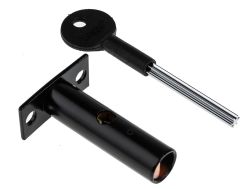
Top Tip!
Avoid using these rack bolts to prop open doors. If the door is knocked or banged, both the door and the bolt can be damaged.

How to Install a Door Security Bolt
You will need a pencil, a drill, 8mm and 16mm drill bits, a chisel, a mallet, and a screwdriver (Pozidriv is recommended), along with screws that are compatible with your chosen door bolt.
Once you have gathered the required items, the installation process is as follows:
Using a pencil, mark the position that the security bolt will take on your door.
Drill a 64mm hole in the door using the 16mm drill bit, clear out the wood shavings, insert the bolt and then trace around the endplate of the bolt. Using this outline, carve a cavity using the chisel so that the bolt plate lies flush with the surface of the door.
Take out the bolt and hold it up against the hole you drilled across the edge of the door and then, using the pencil, mark the position of the keyhole.
Drill a second 64mm hole at the keyhole point, using the 8mm drill bit.
Reinsert the bolt, screw it into position using the endplate and then attach the keyhole plate.
Close the door again and market the centre of the bolt on the door.
Retrieve your drill and reinsert the 16mm drill bit. Now drill a 19mm hole and a second cavity in the door so that the ‘strike plate’ (bracket attached to the doorjamb) also sits flush with the surface of the door.
How to Fit Garage Door Bolts
These box-shaped bolts provide a degree of security for garage doors, which can otherwise be forced by a determined intruder. With a pair of locks that can be opened from both sides with the same key, garage door bolts lock themselves onto the door frame, making forced entry much harder. They are compatible with traditional ‘up and over’ doors, as well as hinged, folding and sliding models.
Garage security bolts can be fitted to each side of the door either horizontally (extending into the garage wall) or vertically (extending into the floor). For additional security, do not drill a keyhole on the outside.
If you are installing bolts on widely used ‘up and over' doors, place them in the bottom corners, around 20mm from the edge of the door. This will allow free access unless the bolts have been locked. The locks will extend the bolts with each turn of the key.
Other Types of Door Bolt
In addition to rack bolts and garage door bolts, you may also encounter the following common types of door bolt:
Sliding Bolts
These common models feature a cylinder into which the bolt slides, which is screwed to the door. They are easy to install and feature various locking options, including padlocks and combinations.
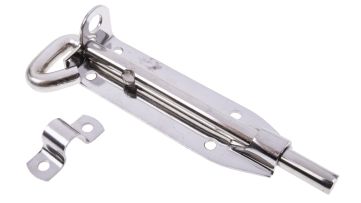
Barrel Bolts
Barrel bolts work on a similar principle to slide bolts but feature a catch plate on the opposite door frame. When the bolt slides into the catch plate, the door is locked. Typically, the bolt is cylindrical but it may have square edges. Barrel bolts function both horizontally and vertically, making them a good choice for sheds, stables, and storage units.
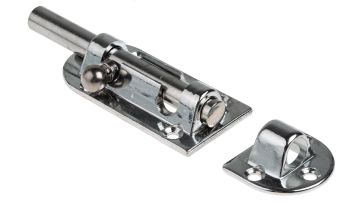
Concealed Door Bolts
As the name suggests, concealed door bolts are installed within the door itself and are not visible from outside. Like other door bolts, they provide reassuring security and are a popular choice for wooden doors and back doors. They are usually installed in pairs using a mortice (insertion joint) These types of bolts usually include a lock which is only accessible from the inside.
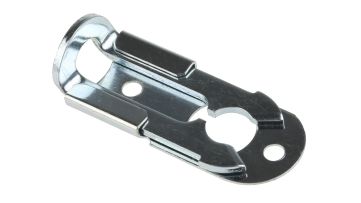
Padlockable Door Bolts
This heavy-duty design is intended for doors in particularly sensitive locations. Made from galvanised steel with a barrel bolt-style strike plate, the attachable padlock provides a robust barrier to protect against unauthorised entry.
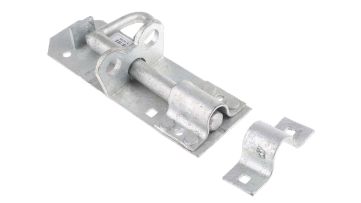
Brass Door Bolts
Brass is an alloy of copper and zinc. It is versatile, inexpensive and relatively easy to manufacture. Brass is highly resistant to corrosion and rust but does not offer the strength of other metals.
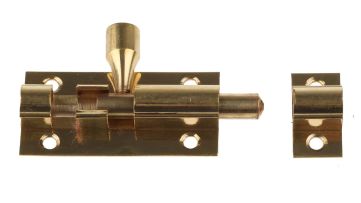
Steel Door Bolts
Steel is an alloy of iron and carbon. It offers good strength at low cost and is highly durable and pressure-resistant.

Straight Barrel Door Bolts
Straight barrel door bolts are a longer and thinner variation of the barrel bolt, offering versatile protection at a lower cost.
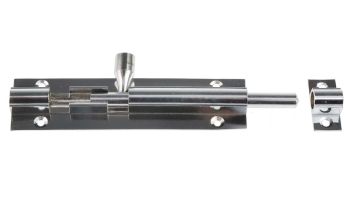
Necked Door Bolts
Necked door bolts are a variation of the basic barrel design with a curved or angled bolt head to reinforce a larger area. They will function both horizontally and vertically.
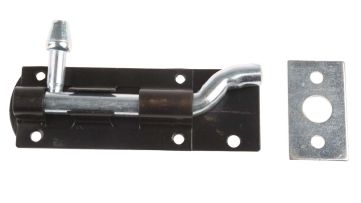
Flush Door Bolts
Flush bolts are designed for use on double doors, especially those where one side is typically unused for long periods. These bolts are fitted within the edge of each door and work by locking the doors in the middle by moving up or down into the door jamb.
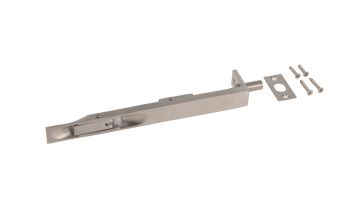
Popular Brands
Pinet
Pinet door bolts are hardwearing and durable. Browse the full range online with RS Components today.
RS PRO
Our in-house brand RS Pro features an extensive range of door bolts in a variety of sizes and finishes. Browse our line today!
Squire
Browse the full range of door bolts from Squire online today with RS Components and discover the product best suited to your requirements.
Southco
Explore door bolts from leading brand Southco, including stainless steel door bolts and thermoplastic slide bolts.